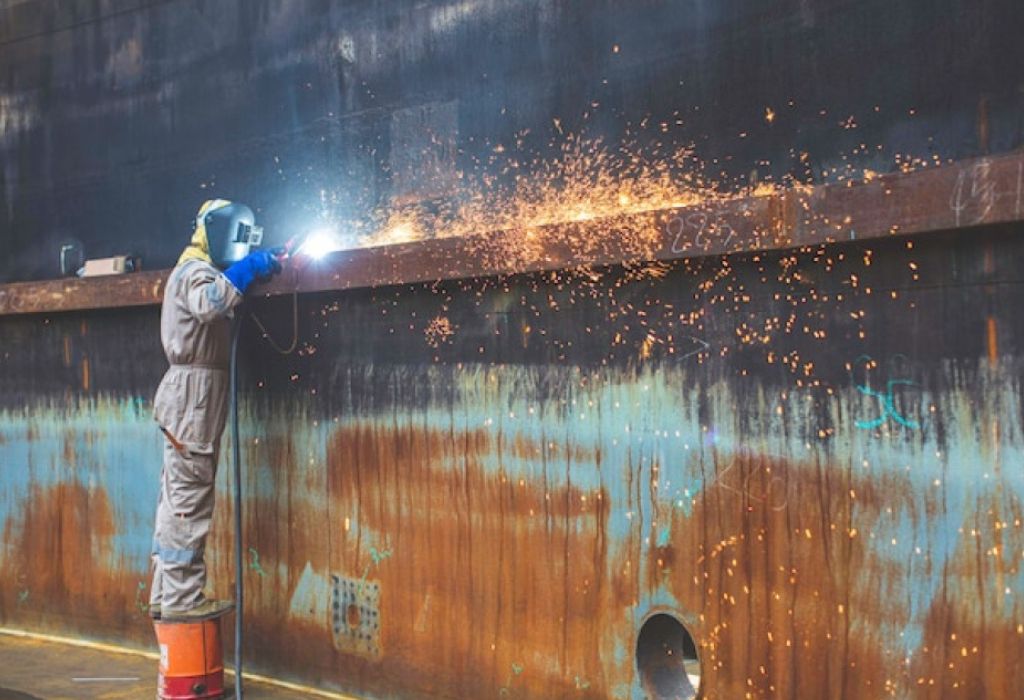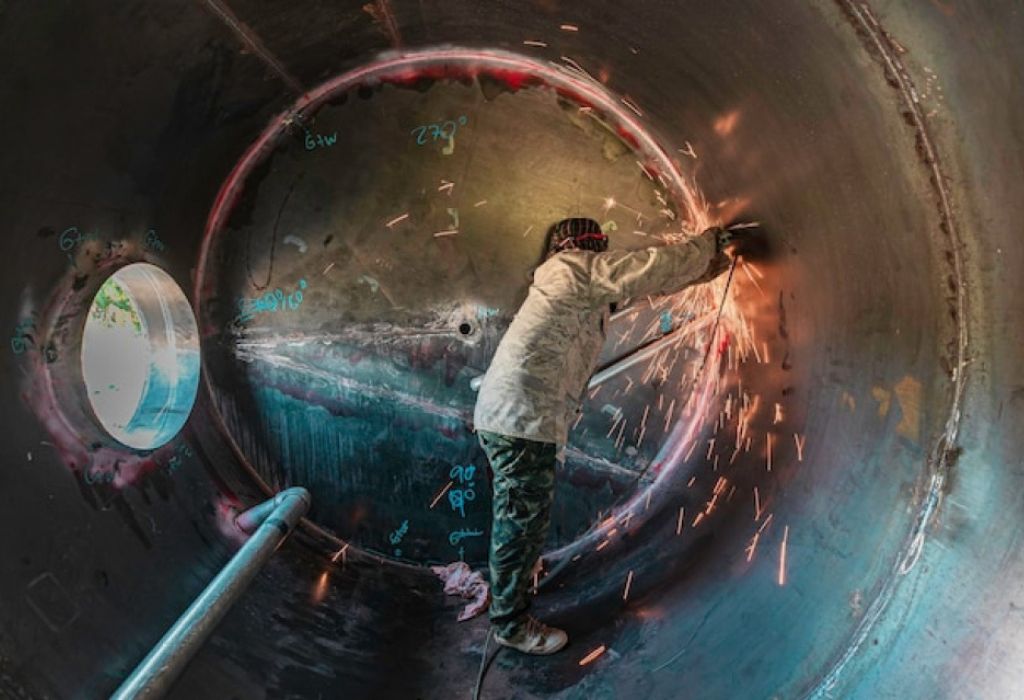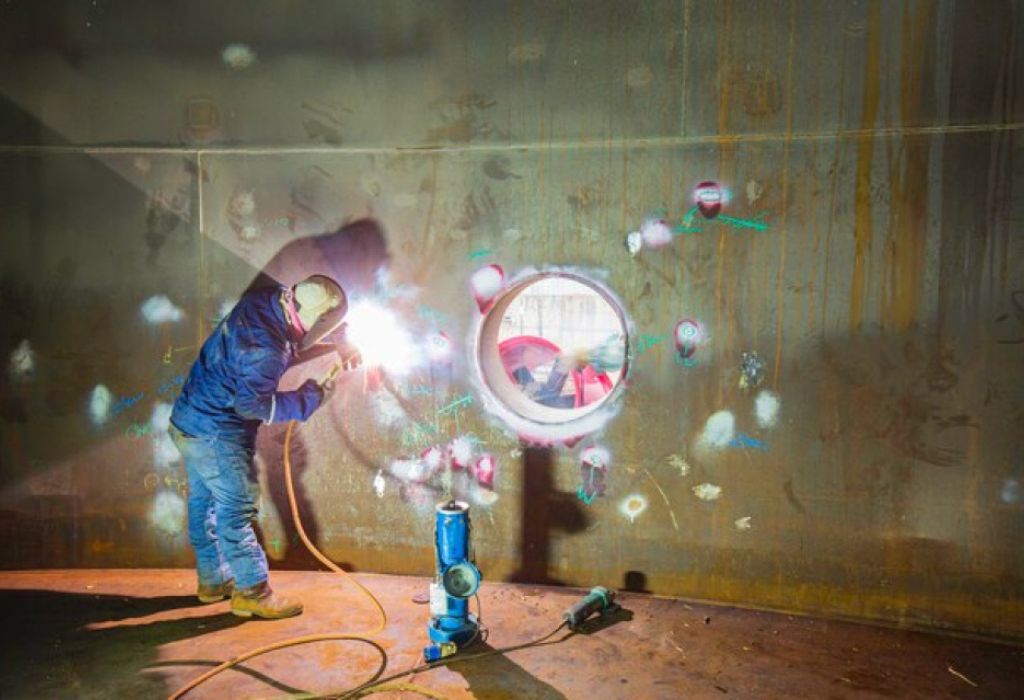A diver descends into the dark waters below an oil platform, carrying tools that must function flawlessly under pressure. T
he task is urgent, the environment unforgiving, and the responsibility immense.
Few jobs combine such danger, technical skill, and reward as underwater welding.
The question many ask is simple: what is an underwater welder, and how do they work in conditions that seem impossible for metal and fire?
The answer reveals a profession that blends two demanding trades — commercial diving and welding — into a single role built on precision, courage, and training.
Underwater welders are essential to maintaining and repairing marine infrastructure, ships, pipelines, and offshore energy systems.
They use advanced techniques such as wet welding with waterproof electrodes or dry welding inside pressurized habitats to create strong, reliable joints.
According to the U.S. Bureau of Labor Statistics, commercial divers, which include underwater welders, earn a median annual wage of $60,470 with top earners making far more in offshore projects [BLS].
The risks are equally significant. Divers must manage decompression schedules, poor visibility, powerful currents, and the dangers of working with electricity underwater.
To control these hazards, strict safety standards from organizations like the Association of Diving Contractors International and the NOAA Diving Manual guide every dive [ADCI] [NOAA].
The benefits, however, are compelling. Underwater welders enjoy some of the highest wages in skilled trades, opportunities to travel worldwide, and the satisfaction of repairing vital infrastructure.
This guide explores what an underwater welder is, how the job works, what skills and certifications are required, and how pay can vary depending on training and location.
What Is an Underwater Welder?

An underwater welder is a commercial diver trained to perform welding and cutting tasks on submerged structures. They combine advanced diving skills with welding expertise to repair, maintain, or build infrastructure beneath the surface.
These professionals work in industries such as offshore oil and gas, shipping, marine construction, and bridge or dam maintenance. Their role is essential to keeping critical underwater assets safe, reliable, and operational.
Is underwater welder a separate license?
No, it is a specialization within commercial diving that follows industry standards and welding codes.
Do underwater welders weld on every dive?
Not always; many dives focus on inspection, cutting, or surface preparation before welding.
Do they use scuba tanks for work?
Most underwater welders use surface-supplied air systems with umbilicals for safety and communication.
What industries employ underwater welders?
They work in offshore energy, shipbuilding, port facilities, and civil engineering projects.
Is underwater welding permanent or temporary work?
Both; some repairs are temporary fixes while others meet strict quality standards for long-term performance.
How Underwater Welding Works: Wet vs Dry (Hyperbaric)
Underwater welding takes two main forms: wet welding and dry or hyperbaric welding. Each approach is chosen based on project needs, cost, and safety requirements.
Wet welding uses waterproof electrodes and is performed directly in the water. Dry welding, by contrast, is done inside a sealed pressurized habitat or cofferdam where water is displaced by gas.
Which is stronger, wet or dry welding?
Dry or hyperbaric welding produces higher-quality welds for critical structures.
Why still use wet welding?
It is faster, cheaper, and effective for emergency or temporary repairs.
What processes are most common?
Shielded metal arc welding is used for wet welding, while gas tungsten and gas metal arc welding are used in habitats.
Does water pressure affect welding?
Yes, high pressure and rapid cooling influence arc stability and weld metallurgy.
Which industries use both types?
Marine construction, offshore energy, and ship repair rely on both depending on the project.
Day-to-Day Duties and Tools
The work of an underwater welder involves much more than welding. Tasks often include inspection, cutting, grinding, rigging, and installation of protective systems.
Tools include surface-supplied dive gear, communication systems, waterproof electrodes, power sources, and oxy-arc cutting equipment. Specialized habitats and cofferdams may be used for dry welding.
Do underwater welders plan their own procedures?
They follow project Welding Procedure Specifications and AWS codes.
How long do divers stay underwater?
Bottom times depend on depth, project complexity, and decompression requirements.
Is most work offshore?
Many jobs are offshore, but inland work on bridges and dams is also common.
What non-welding tasks do they perform?
They often install clamps, perform NDT prep, and handle cathodic protection systems.
Do they work alone?
No, underwater welders always work as part of a supervised dive team.
Skills You Need to Become an Underwater Welder
Underwater welders require strong technical and physical skills. They must master welding processes while maintaining diving fitness and safety discipline.
Key skills include SMAW, GMAW, and GTAW fundamentals, metallurgy basics, blueprint reading, and NDT awareness. Diving skills include buoyancy control, underwater communication, and endurance in challenging conditions.
Do welders train as divers first?
Many begin as welders before attending commercial diving school.
Is physical fitness required?
Yes, strict medical and fitness standards are mandatory.
Are soft skills important?
Yes, teamwork and problem-solving are essential under time pressure.
Do they need blueprint reading?
Yes, accurate interpretation ensures safe and precise work.
Is underwater welding mentally demanding?
Yes, divers must remain calm and focused in high-risk environments.
Training, Certifications, and Standards

Becoming an underwater welder requires accredited commercial diving training combined with welding experience. Industry standards ensure safety and competence.
Training follows guidance from the Association of Diving Contractors International and the NOAA Diving Manual. Welding procedures are governed by AWS D3.6M, the code for underwater welding.
Is AWS certification required?
Many employers require proof of competence under AWS D3.6M procedures.
Where do divers train?
Reputable commercial diving schools offer underwater welding modules.
Do scientific divers follow the same rules?
Scientific programs follow different manuals but share similar safety principles.
Are certifications recognized internationally?
Yes, many standards align with global frameworks such as IMCA.
How long does training take?
Most programs last several months to a year depending on specialization.
Safety, Risk, and Quality Control
Underwater welding is inherently dangerous. Hazards include poor visibility, strong currents, entanglement, differential pressure, and decompression sickness.
Strict procedures, supervision, and safety equipment are required. Quality control includes visual inspections, NDT methods, and strict adherence to Welding Procedure Specifications.
Is wet welding unsafe?
It is safe when performed under recognized procedures and supervision.
Who oversees safety?
Dive supervisors and project inspectors enforce safety standards.
Do divers face electric shock risk?
Yes, but waterproof equipment and procedures minimize the danger.
Is decompression illness common?
It is rare when divers follow tables and schedules.
Can underwater welds be inspected?
Yes, they undergo rigorous inspection and testing.
Salary and Earning Potential
Underwater welding is one of the highest-paying skilled trades. Pay depends on industry, location, and level of experience.
According to BLS, commercial divers earn a median salary of $60,470, with the top 10 percent earning more than $100,000 annually [BLS]. Offshore projects often pay higher rates due to risk and complexity.
Do underwater welders make six figures?
Yes, experienced offshore divers often earn six-figure incomes.
Is offshore pay higher than inland pay?
Yes, offshore projects usually offer hazard premiums and overtime.
Do certifications impact pay?
Yes, AWS and ADCI qualifications increase earning potential.
What do entry-level welders earn?
New divers often start near regional averages before advancing.
Are jobs stable year-round?
Work often depends on project demand and weather conditions.
Wet Welding vs Dry Welding: Pros and Cons
Both wet and dry welding have unique strengths. Wet welding is cheaper and faster, while dry welding produces stronger, longer-lasting welds.
Employers select the method based on cost, accessibility, and structural requirements. Critical structures typically require dry or hyperbaric welding.
Which method is better for pipelines?
Dry welding provides higher integrity for pipelines.
Which is more cost-effective?
Wet welding is faster and less expensive.
Which is most common?
Wet welding is widely used for temporary repairs.
Does dry welding require more setup?
Yes, habitats or cofferdams must be prepared.
Do both methods require AWS compliance?
Yes, both must meet AWS D3.6M code requirements.
Inland vs Offshore Work
Inland underwater welders maintain bridges, dams, and water tanks. Offshore welders work on oil rigs, subsea pipelines, and marine structures.
Offshore work usually pays more but involves extended rotations and harsher conditions. Inland work provides more stable schedules and less travel.
Who hires inland welders?
Civil construction firms and marine contractors.
Who hires offshore welders?
Energy service and subsea construction companies.
Which is better for beginners?
Many divers start inland before advancing to offshore projects.
Is offshore work more dangerous?
Yes, offshore projects face stronger currents and deeper depths.
Do both offer career growth?
Yes, both inland and offshore roles lead to supervisory positions.
Career Path and Specializations

Underwater welders often begin as tenders or entry-level divers. With experience, they advance to welder-divers, supervisors, and inspectors.
Specializations include hyperbaric welding, pipeline repair, NDT inspection, and saturation diving. Many move into project management or training roles.
Can welders transition to inspection?
Yes, many pursue certification as inspectors or supervisors.
Do ROVs replace divers?
No, ROVs support divers but cannot perform all welding tasks.
What is saturation diving?
A method where divers live in pressurized chambers for deep, extended work.
Do welders need management skills?
Yes, leadership is essential for supervisory roles.
Are there international opportunities?
Yes, skilled underwater welders work worldwide.
Future Trends in Underwater Welding
The field is evolving with new technologies. Robotics, remote monitoring, and advanced consumables are changing how projects are managed.
Expect growth in digital QA systems, video recording of welds, and improved electrodes for wet welding. These trends increase safety and efficiency.
Will robots replace underwater welders?
No, they assist but cannot fully replace human skill.
What is the newest innovation?
Advanced wet welding electrodes with improved arc stability.
Will digital systems become mandatory?
Yes, video documentation and remote supervision are increasingly required.
Are hyperbaric habitats improving?
Yes, modern habitats offer better environmental control.
Will demand for welders grow?
Yes, global infrastructure and energy projects drive demand.
Conclusion
An underwater welder is a commercial diver who combines welding expertise with the ability to work in extreme conditions. Their role is vital to industries that depend on strong, reliable underwater structures.
The career offers high pay, global opportunities, and unique challenges. Success requires specialized training, certifications, and strict adherence to safety standards.
For those willing to meet these demands, underwater welding provides one of the most adventurous and rewarding paths in skilled trades.

I’m Darrell Julian, the founder, lead writer, and hands-on welding enthusiast behind ArcWeldingPro.com. With more than 15 years of real-world welding experience, I created this platform to share what I’ve learned in the field, in the shop, and in the heat of the arc.


